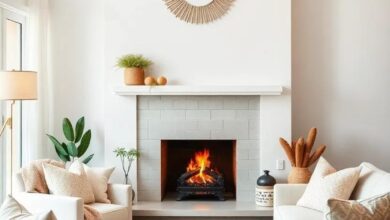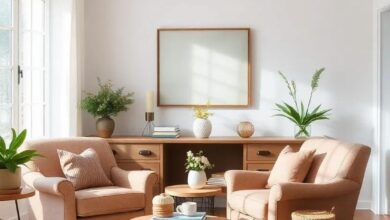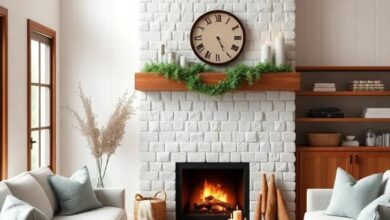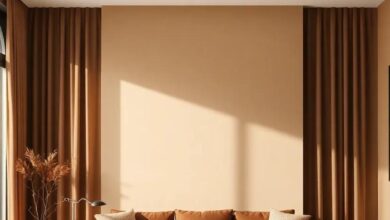Embracing Change: Designing Transitional Living Rooms for Modern Apartment Life
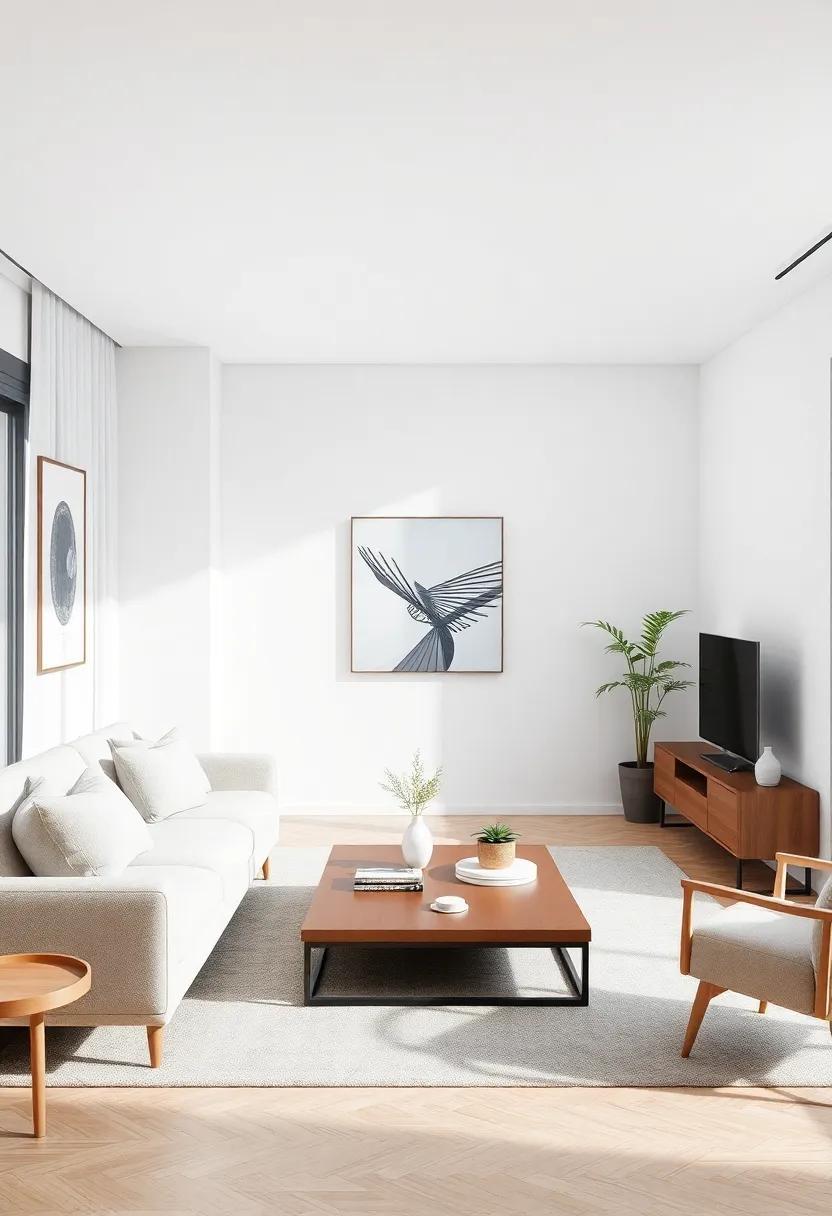
In the ever-evolving tapestry of urban living, the conventional confines of home are morphing into dynamic spaces that reflect the rhythms of modern life. As lifestyles shift and priorities transform, the living room—the heart of our homes—stands at the forefront of this change. No longer merely a static space for social gatherings, today’s living rooms must adapt to a multitude of functions, from cozy retreats to multifunctional hubs that accommodate both work and leisure. In this article,we delve into the art of designing transitional living rooms that not only embrace change but celebrate it,providing innovative solutions for apartment dwellers navigating the complexities of contemporary life. Join us as we explore creative approaches,versatile designs,and practical tips to reimagine your living space into a sanctuary that harmonizes with the needs of our fast-paced world.
Embracing the Versatility of Modern Transitional Living Spaces
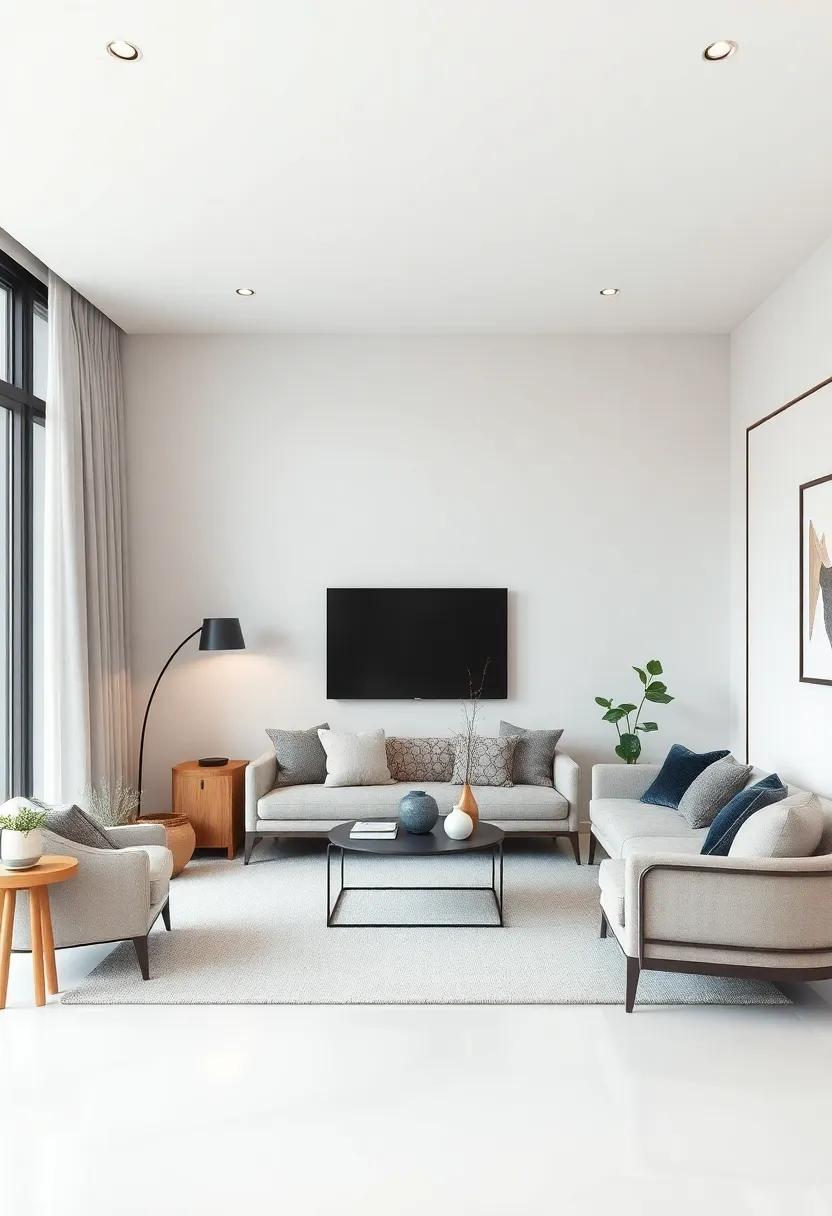
Modern transitional living spaces seamlessly blend the past with the present, offering a canvas that welcomes both contemporary trends and classic elegance.These designs prioritize functionality and comfort, allowing homeowners to adapt their spaces to a variety of activities, whether it’s hosting a family gathering or enjoying a quiet evening alone. Key elements of this style typically include:
- Neutral Color Palettes: Soft greys, whites, and earthy tones create a serene backdrop.
- Mixed Materials: Combining wood, metal, and textiles enhances the visual interest.
- Flexible Furniture: Pieces that serve multiple purposes cater to the dynamic needs of modern life.
- thoughtful Lighting: A mix of natural light and layered artificial lighting fosters an inviting ambiance.
To make the most of these adaptable spaces,consider incorporating elements that reflect your personal taste while maintaining a sense of cohesion. You might find that integrating a variety of textures, such as plush cushions or sleek leather, can transform a simple area into a welcoming retreat. Moreover, the incorporation of artwork and decor items that resonate with your unique style can establish a narrative that personalizes the space. Below is a simple comparison table to illustrate how different design choices can impact the vibe of your living area:
| Design Element | Impact on Space |
|---|---|
| Warm Tones | Creates a cozy and inviting atmosphere |
| Bold Patterns | Adds character and visual interest |
| Minimalist Decor | Promotes calm and simplicity |
| Indoor Plants | Enhances air quality and adds life |
Capturing the Essence of Comfort in Small Apartment living Rooms
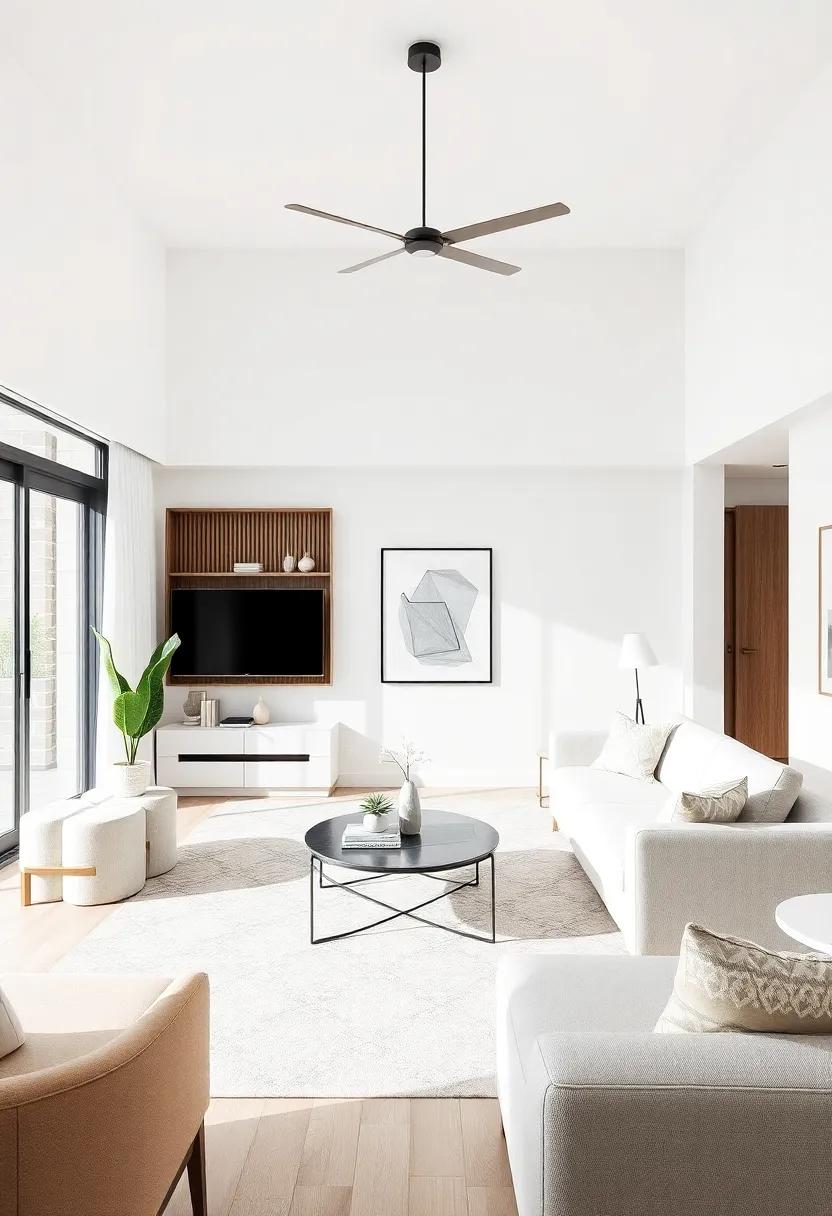
In the bustling life of modern city living, small apartment living rooms serve as sanctuaries that reflect personal style while providing a cozy atmosphere.Creating warmth in these compact spaces can be achieved through layered textiles, strategic lighting, and thoughtfully curated decor. Consider incorporating a mix of textures, such as velvets, knits, and woven materials, to add depth and invite a sense of tactile comfort. Large area rugs can define seating areas, while plush cushions and throws transform the space into an inviting retreat where relaxation is a priority.
To enhance the comforting essence of a small living room, it’s essential to choose furniture that balances functionality and aesthetics. Opt for multi-functional pieces like a stylish coffee table with storage or a sofa bed for guests, allowing for both practicality and chic design. When it comes to colors, soft, muted tones can lend to a tranquil environment, while occasional splashes of vibrant hues can infuse energy into the decor. A well-placed mirror can also amplify the light and create an illusion of a larger space. Don’t forget the importance of greenery—incorporating plants not only purifies the air but also adds a vibrant, lively touch. Here’s a fast look at ideas to elevate your small living room:
| Element | Description |
| Textiles | Use a mix of cushions, throws, and an area rug for comfort. |
| Furniture | Choose pieces that are multifunctional to maximize space. |
| Color Palette | Incorporate soft tones with accents of brighter colors. |
| Lighting | Layered lighting enhances mood and depth in the room. |
| Plants | Add greenery for a natural touch and improved air quality. |
Blending Aesthetic and Functionality in Your Living Design
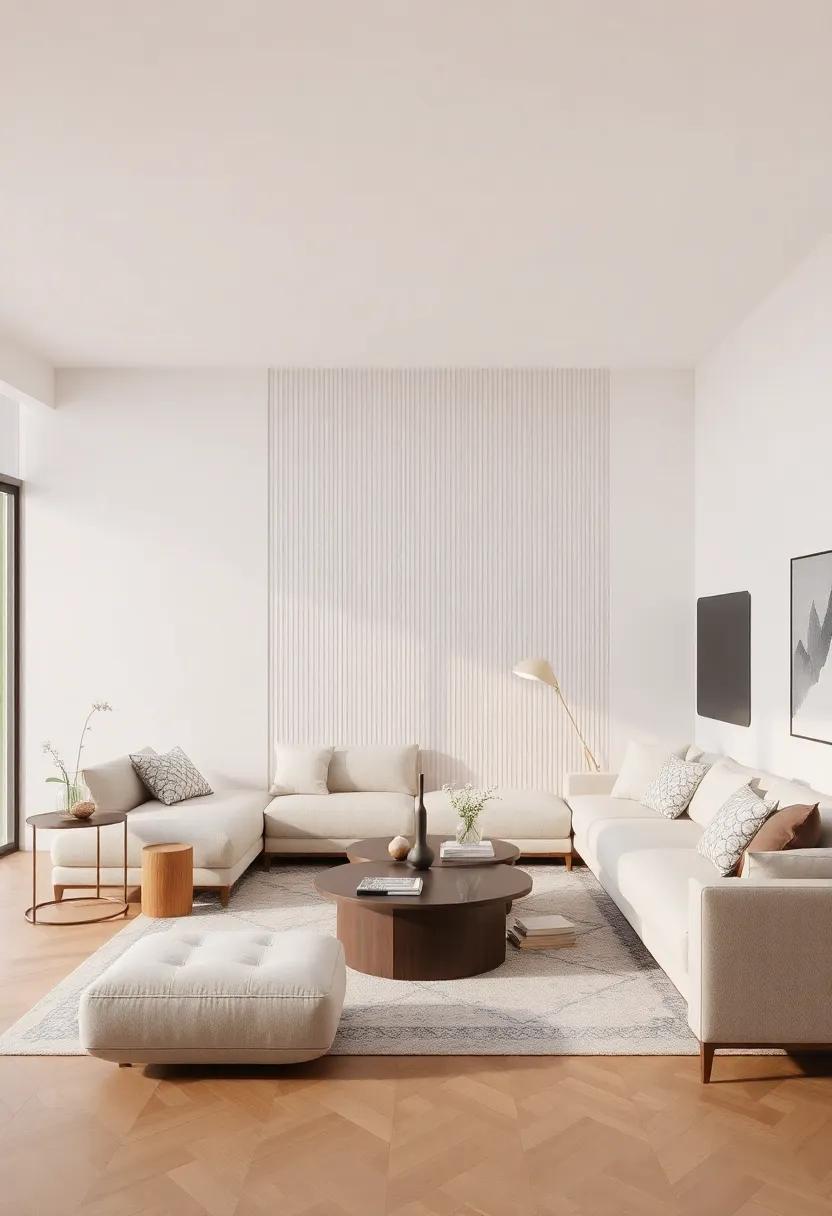
Transforming a living space into a haven of both beauty and utility requires a delicate balance of elements. Consider incorporating multi-functional furniture to maximize every square inch. For example, a stylish coffee table with built-in storage can serve as a centerpiece while keeping essentials neatly tucked away. adding modular seating not only provides cozy options for social gatherings but also allows for versatility in arrangement,adapting to your lifestyle needs. The inclusion of natural light through large windows or strategically placed mirrors can create an illusion of space, merging aesthetic appeal with practical living.
When choosing a color palette, opt for neutral tones complemented by bold accents to inject personality into the room without compromising on serenity.Materials such as wood, metal, and textiles can be combined to create a layered effect that speaks to modern design trends while ensuring functionality. Don’t forget to incorporate greenery through plants, which not only enhance visual interest but also improve air quality.To aid in your planning, consider this simple table with essential transitional living room elements:
| Element | Functionality | Aesthetic Appeal |
|---|---|---|
| Modular Sofa | Adaptable seating options | Contemporary appeal |
| Coffee Table with Storage | Organization & convenience | Stylish centerpiece |
| Wall Art | Personal expression | Enhances room character |
exploring Color Palettes That Inspire Warmth and Transition
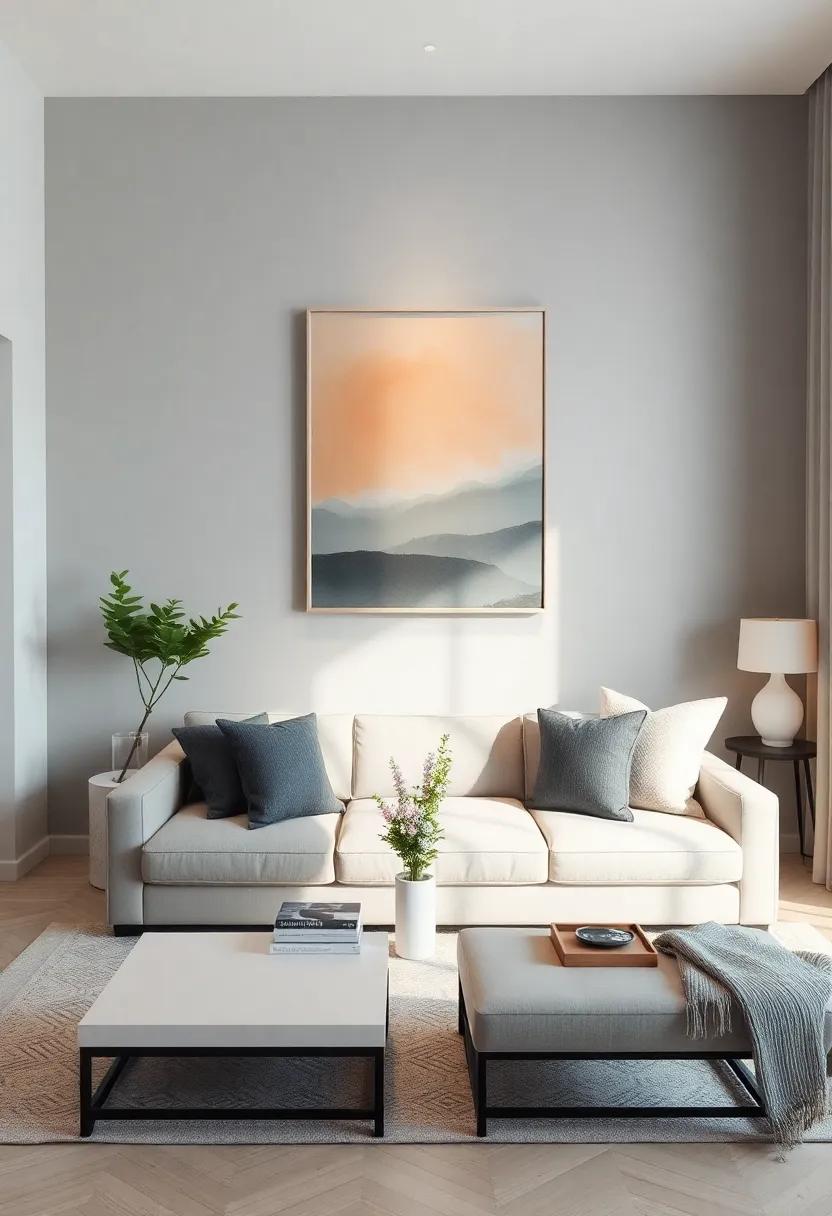
In an apartment where space is often limited, choosing the right color palette can evoke feelings of comfort and harmony while highlighting the dynamic nature of urban life. Soft neutrals can serve as a stunning backdrop, setting the stage for deeper shades that introduce a touch of warmth. Imagine incorporating tones such as dusty rose, creamy beige, and warm gray; together, these hues create an inviting atmosphere. To add character, introduce vibrant accents like mustard yellow or teal through throw pillows, rugs, or artwork. This thoughtful mix not only frames the living area beautifully but also transitions effortlessly with the seasons, reflecting the evolution of both nature and personal style.
To refine the warmth in your living space, consider implementing a layered approach to color. Start with a base color for larger furniture pieces—think earthy greens or soft browns—and accentuate with textured fabrics in complementary shades. A visual interest can be created by displaying colors such as rich terracotta or warm olive in selected decor items. Below is a simple table that showcases color roles and their emotional impacts in a transitional living room:
| Color Role | Example Colors | Emotional Effect |
|---|---|---|
| Base | Earthy Green, Soft Brown | Grounding and Inviting |
| Accent | Mustard Yellow, Teal | Playful and Cheerful |
| Textured | Rich Terracotta, Warm Olive | Warm and Cozy |
Maximizing Natural Light to Enhance Your Living Environment
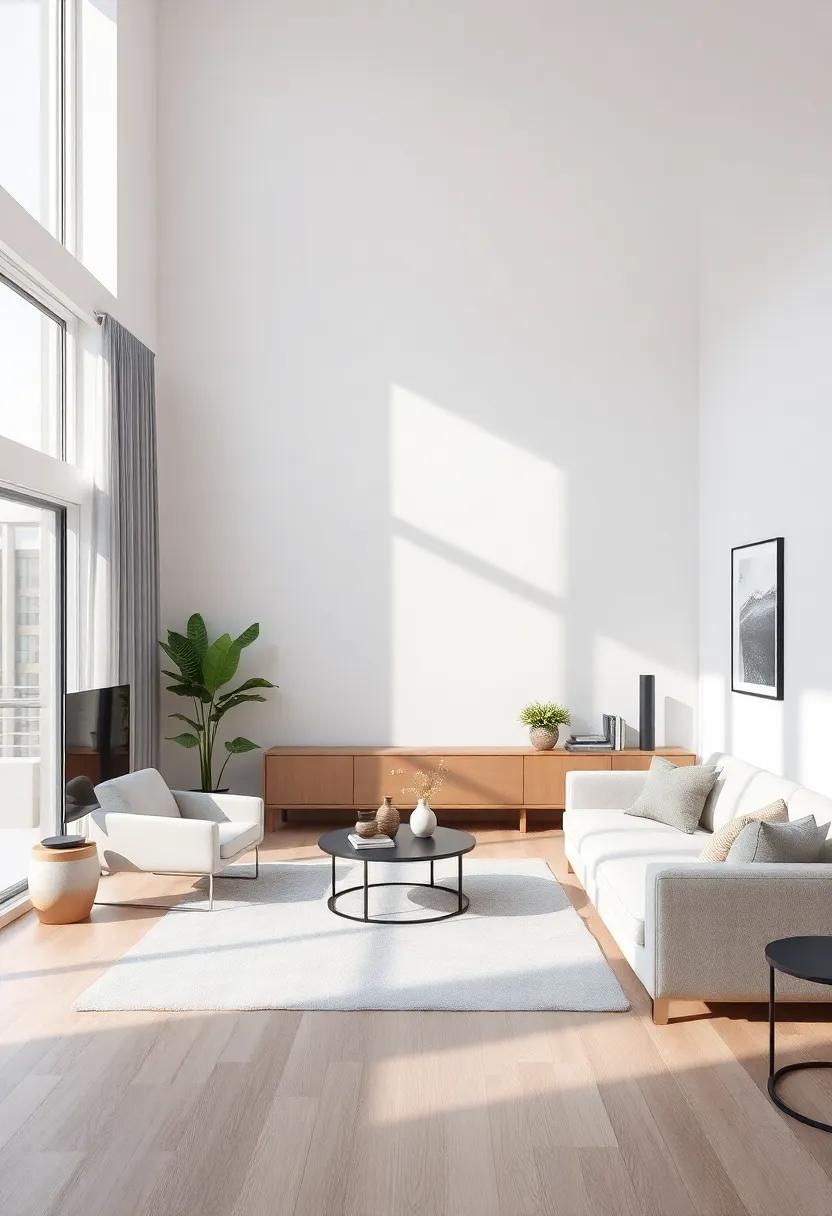
Natural light transforms a living space,breathing life into its design and functionality. To maximize sunlight, consider the strategic placement of mirrors that reflect light around the room. This not only creates a brighter environment but also enhances the sense of space. opt for light, airy curtains that allow the sun to filter through while providing a level of privacy. In addition, choose lighter color palettes for walls and furniture; soft hues can amplify the impact of natural light and foster a tranquil ambiance.
Incorporating open-concept layouts can further enhance the flow of natural light between rooms. To illustrate this concept, here’s a simple overview of various design elements that can impact light distribution:
| Design Element | Impact on Light |
|---|---|
| Large Windows | Maximize sunlight intake |
| Skylights | Bring in overhead light |
| Open Shelving | Allows light to travel freely |
| Glass Doors | Connect indoor and outdoor spaces |
By thoughtfully incorporating these elements, your living area can reflect a delightful balance between modern design and natural illumination, creating an inviting atmosphere that resonates with comfort and serenity.
Incorporating Multi-Functional Furniture for Every Lifestyle
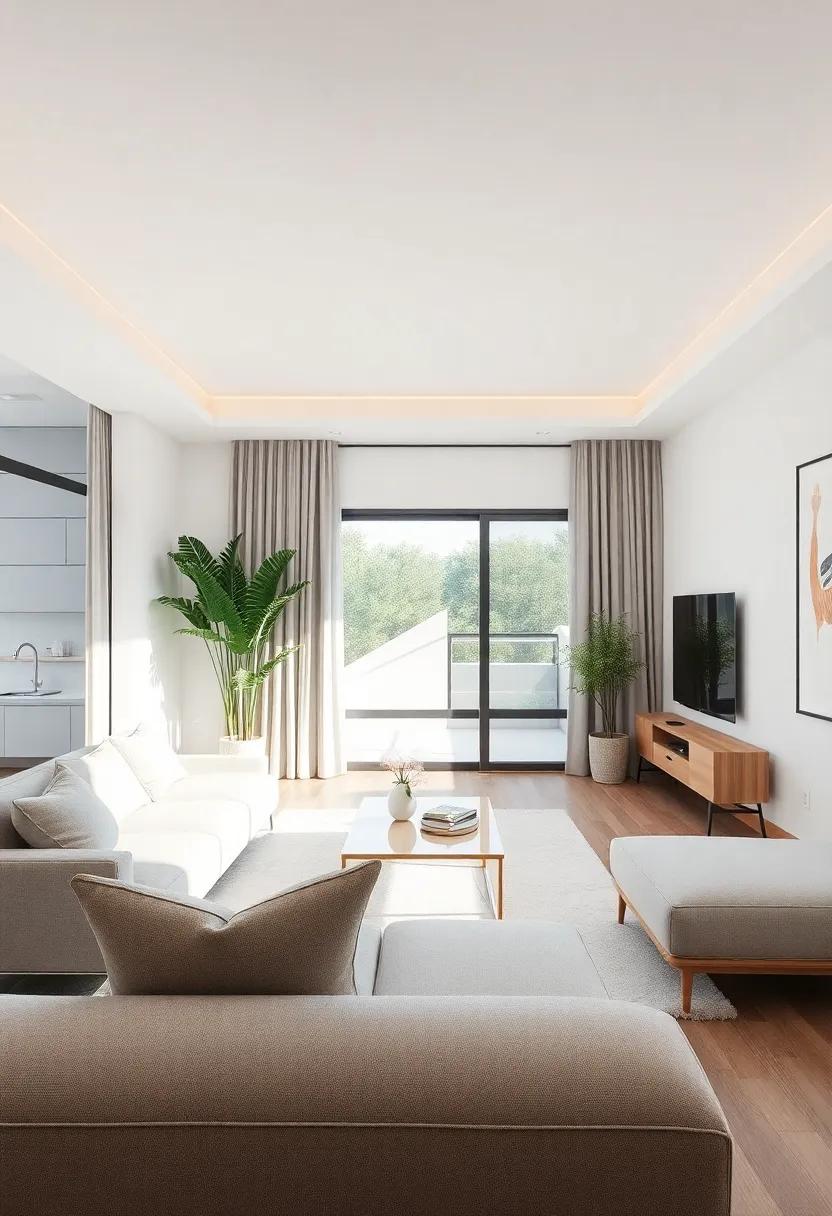
In modern apartment living, the need for space-efficient solutions is more crucial than ever. Embracing the versatility of multi-functional furniture not only enhances your living area but also reflects your lifestyle. consider incorporating items such as:
- Sofa beds that effortlessly transition from seating to sleeping arrangements.
- Ottomans with storage to keep your space tidy while offering extra seating.
- Expandable dining tables that can accommodate cozy dinners or larger gatherings.
These innovative pieces activate your space, allowing for a seamless flow from day to night.By blending form with function, you can create an inviting atmosphere that suits various activities — whether it’s hosting friends, enjoying a quiet evening, or juggling work tasks at home.
| Furniture Piece | Functionality | Ideal For |
|---|---|---|
| Sofa Bed | Seating & Sleeping | Guests |
| Storage Ottoman | Storage & Seating | Small Items |
| Expandable Table | Dining & Workspace | Entertaining |
This approach encourages an adaptable space that thrives on innovation and functionality, making your living room the ultimate reflection of your unique needs and tastes. Involving your furniture in both aesthetic appeal and practical use can transform a transient environment into a cohesive sanctuary.
Creating Cozy Nooks for relaxation and Reflection
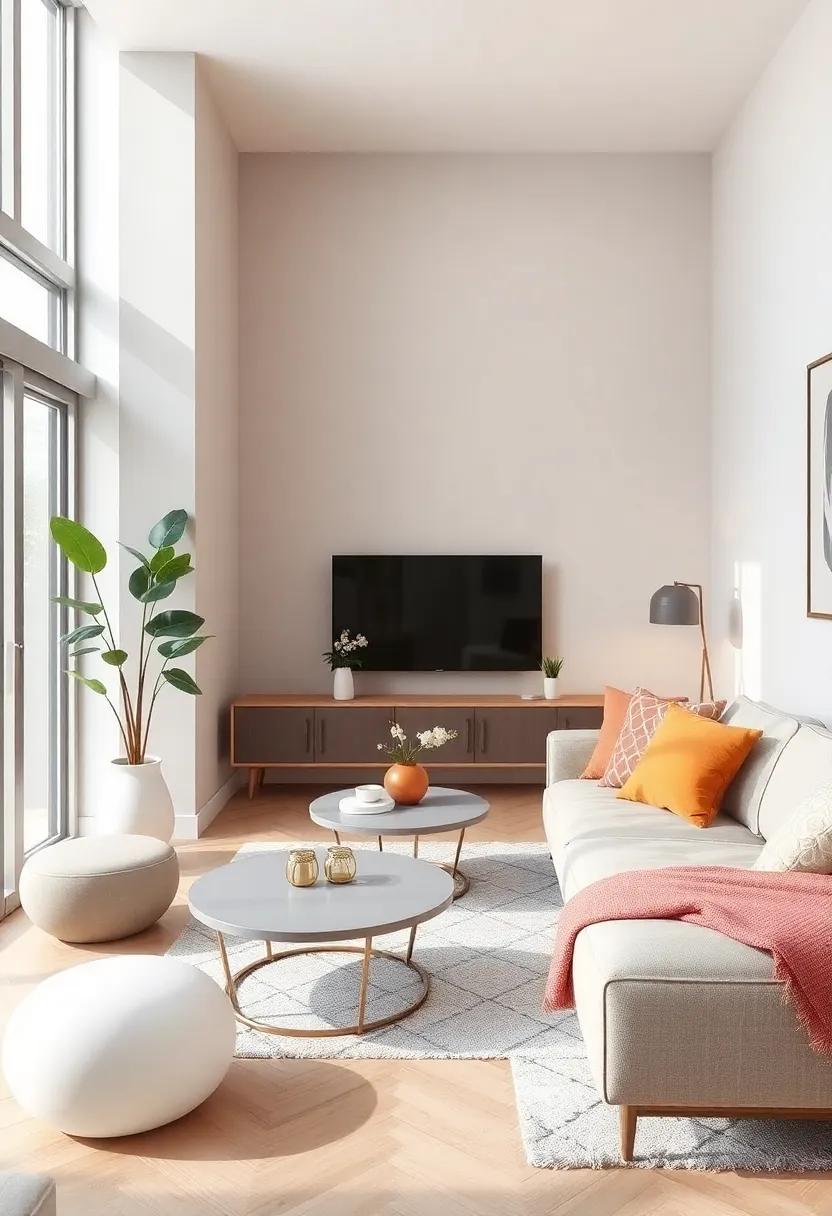
To cultivate an atmosphere of tranquility in your living space, consider integrating cozy nooks that beckon you to unwind. Start by identifying a quiet corner in your room, ideally by a window or near a bookshelf. Furnish this space with comfortable cushions, a soft throw blanket, and perhaps a small side table to hold a cup of tea or your favorite book. Enhance the ambiance with warm lighting; string lights or a stylish floor lamp can create an inviting glow that encourages relaxation and introspection.
Moreover, personal touches can transform these nooks into sanctuaries of peace. Think about adding elements that resonate with your personality: printed artwork, cherished photographs, or a small plant to breathe life into the space. You can further define the nook’s atmosphere by incorporating a delicate aroma diffuser or scented candles,casting soft fragrances that soothe the mind. When designing such spaces, remember that the essence lies in simplicity and comfort, making them perfect for moments of reflection amid your busy apartment life.
The Art of Layering Textures for Depth and Interest
Creating a living room that is both stylish and functional involves the careful orchestration of various materials that evoke a sense of warmth and sophistication. By incorporating an array of textures,designers can add layers of depth,turning a simple space into a sanctuary. Consider using a mix of textiles—soft cotton throw pillows, a chunky knit blanket draped over the arm of a chair, and sleek silk curtains. This combination not only invites touch but also creates a visual interest that plays with light and shadow, enhancing the overall ambiance.
Additionally, the integration of natural elements can greatly enrich the layered aesthetic of the room. Introducing items such as textured wood furniture, stone accents, and woven baskets brings an organic quality that ground the space. You might explore options such as:
- Wood: A reclaimed wood coffee table paired with smooth, minimalist seating.
- Metal: Incorporating metallic finishes through decorative accents like lamps or picture frames.
- Glass: Glass vases filled with fresh flowers can add both texture and clarity.
When combining these elements, remember to maintain a cohesive color palette to ensure everything feels unified yet dynamic. The thoughtful selection of textures can transform your apartment’s living room into a multi-dimensional space, inviting relaxation while serving as a conversation starter.
Integrating Personal Touches to Reflect Individual Style
In the quest to create a living room that reflects your personal style, it’s essential to incorporate elements that resonate with your individuality.This can range from selecting distinctive furniture pieces to choosing artwork that tells your story. Consider mixing different textures and colors that not only add depth but also make the space uniquely yours. Here are some ideas to inspire your design:
- personal Artwork: Displaying pieces from local artists or family creations adds character.
- Textile Choices: use throw pillows and blankets that reflect your favorite colors or patterns.
- Unique Décor Items: Incorporate heirlooms or souvenirs from your travels as conversation starters.
Another way to bring your personality into the space is through practical accents. Opt for furniture that serves multiple purposes while being lovely in design, like a stylish coffee table that stores books or a sofa with contrasting cushions. Don’t shy away from lighting options that give your room a warm glow and express your aesthetics. Below is a simple overview of functional yet stylish living room elements:
| Element | Style Impact | Functionality |
|---|---|---|
| Multi-functional Coffee Table | Modern aesthetic | Storage and surface |
| Statement Floor Lamp | Eye-catching design | Ambient lighting |
| Artistic Side Chairs | Reflective of taste | Extra seating |
Harnessing technology for a Seamless Living Room experience
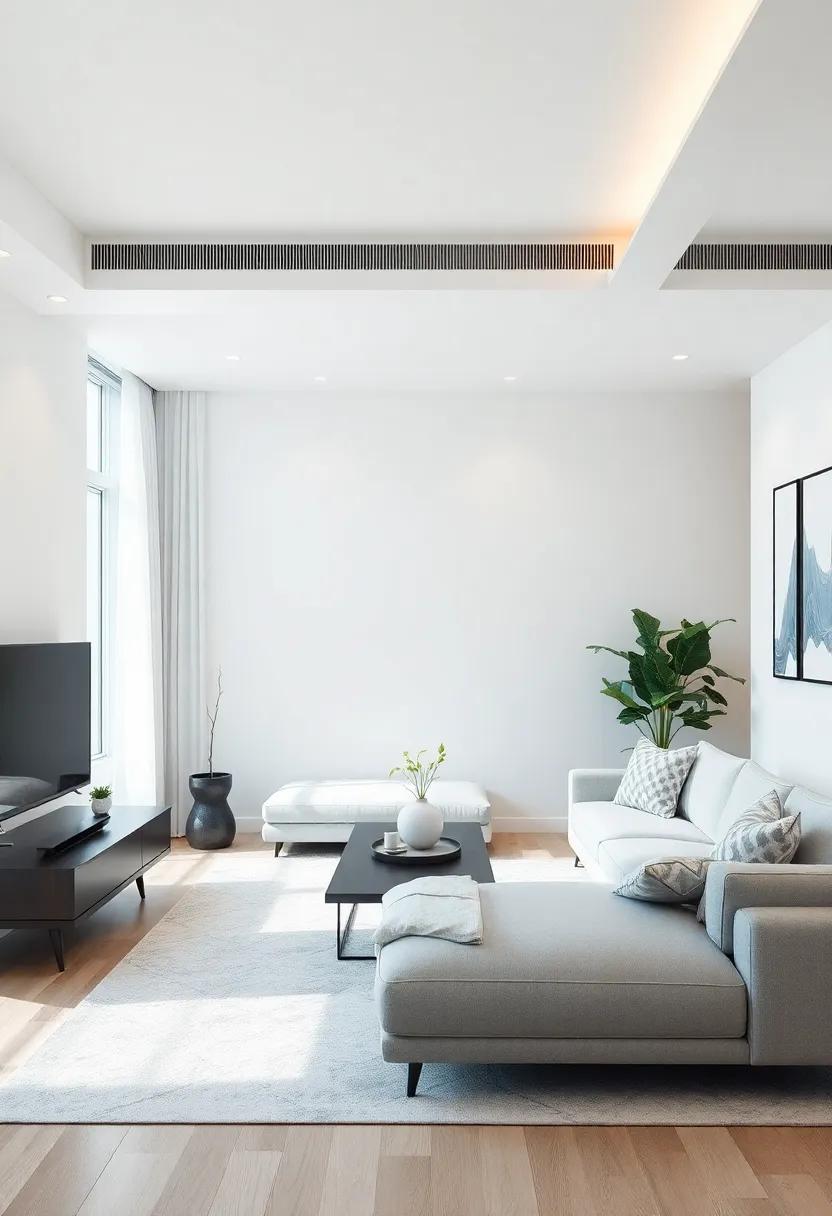
In today’s fast-paced world, integrating technology into our living spaces has become essential for enhancing everyday comfort and convenience. Imagine a living room where you can control lighting, temperature, and even entertainment systems through a single device. Smart home devices like voice-activated assistants and automated lighting enhance functionality while adding a sleek, modern touch to the ambiance. Key features to consider include:
- Smart Lighting: Adjust brightness and color to suit your mood or activity.
- Multi-Room Audio: Enjoy seamless music throughout your apartment, from the living room to the kitchen.
- Integrated Screens: Hide televisions and displays within stylish cabinetry when they’re not in use.
Furthermore, optimizing your living room for smart technology allows for a more cohesive and interactive space. the aesthetic appeal of transitional design can seamlessly blend tech elements, ensuring they complement rather than overpower the room’s aesthetics. Consider a layout that fosters connection, such as:
| element | Impact |
|---|---|
| Flexible Furniture | Facilitates easy reconfiguration while accommodating tech devices. |
| modular Designs | Provides adaptability to integrate new technologies as they emerge. |
| Discreet Cable Management | Keeps the space clean and organized, enhancing the overall aesthetic. |
Designing a Flowing Layout for Effortless Movement
Creating a layout that encourages movement and interaction is crucial for modern living spaces, especially in transitional living rooms. To achieve a sense of flow, consider utilizing open-concept designs that minimize barriers between the kitchen, dining, and living areas.This not only allows for better connectivity among spaces but also enhances the overall spaciousness. Implementing elements like multi-functional furniture can further curate a seamless transition.Such as, a stylish ottoman can serve as both storage and extra seating, while a lightweight coffee table can be moved easily to adapt to various activities.
Incorporating a natural color palette along with strategically placed lighting also helps enhance the sense of movement throughout the room. Soft, neutral tones create a calming backdrop that allows furniture pieces to shine without overwhelming the space. Consider integrating mirrors to reflect light and space, enhancing the airy feel. A carefully curated layout can also guide the eye effortlessly from one area to another, which can be achieved through orderly arrangements and clear pathways. Here are some essential design tips:
- Opt for flexible seating arrangements
- Use area rugs to define spaces
- Maintain clear sightlines
- Incorporate plants for organic flow
| Design Element | Function |
|---|---|
| Open Spaces | Encourages movement and interaction |
| Multi-Functional Furniture | Maximizes usability |
| Natural Light | Enhances ambiance and openness |
| Coordinated Color Scheme | Promotes visual harmony |
Utilizing Open spaces to Foster Connection and Community
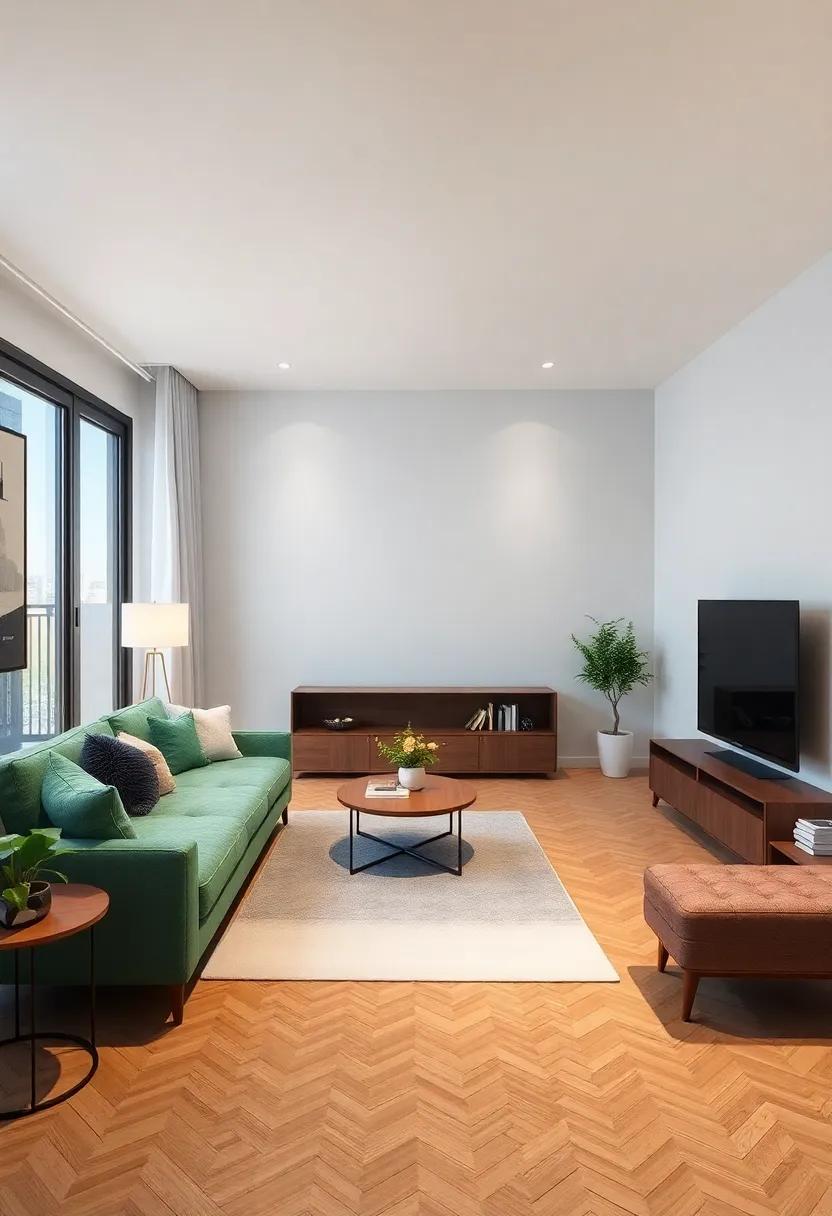
Open spaces in modern apartment designs serve as vital conduits for interaction among residents, allowing individuals to step outside their private confinements and embrace a sense of belonging. By incorporating communal gathering areas such as gardens, courtyards, and lounge spaces, the architecture of transitional living rooms can be purposefully planned to cultivate social bonds. These areas can be enriched with features like:
- Seating Arrangements: Cozy nooks or benches that encourage conversation.
- shared gardens: Community gardening opportunities that foster collaboration.
- Activity zones: Spaces designated for games,yoga,or movie nights.
By thoughtfully designing these open spaces, residents are more likely to engage with one another and share experiences, leading to thriving community dynamics. This approach can be enhanced by implementing multifunctional furniture in transitional living areas, which can shift based on the activities at hand, promoting adaptability and collaboration. Consider a space layout that includes:
| Furniture Type | Functionality |
|---|---|
| Sofas with Storage | Provides seating while reducing clutter. |
| Expandable Tables | Encourages group dining and activities. |
| Movable Partition Walls | Creates flexible activity zones as needed. |
Selecting Statement Pieces That Transform Your Living Area
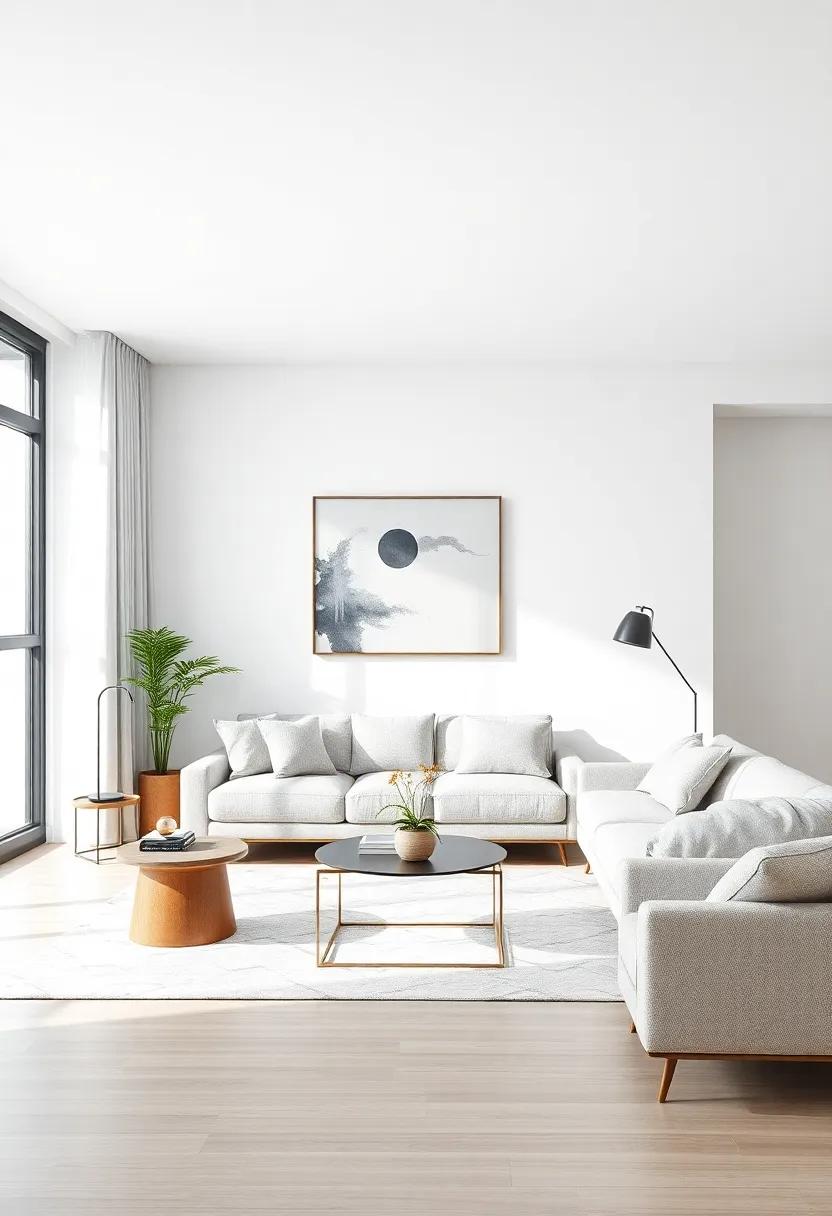
When looking to enhance your living space, focus on statement pieces that capture attention while reflecting your unique style. Consider selecting a bold, oversized artwork or a striking swivel chair that serves as a conversation starter. Incorporating a diverse range of materials can create a rich visual tapestry; think about combining natural woods, metals, and textiles. These elements can work harmoniously to add depth and interest, transforming the atmosphere of your apartment into somthing vibrant and engaging.
Another effective approach is to utilize functional decor that marries function with flair. Items like an eye-catching coffee table or an architecturally engaging bookshelf not only serve a purpose but also elevate the overall aesthetic. To make the selection process easier, consider categorizing your favorite pieces based on their impact level:
| Impact Level | Examples |
|---|---|
| High | Oversized Art, Stylish Sofa |
| Medium | Accent Chairs, Decorative Rugs |
| Low | Unique lamps, Statement Plants |
Evaluating pieces through this lens can ensure you choose statement items that will not only enhance the look of your living area but also create a cohesive design narrative throughout your home.
balancing Minimalism and Comfort in Transitional Designs
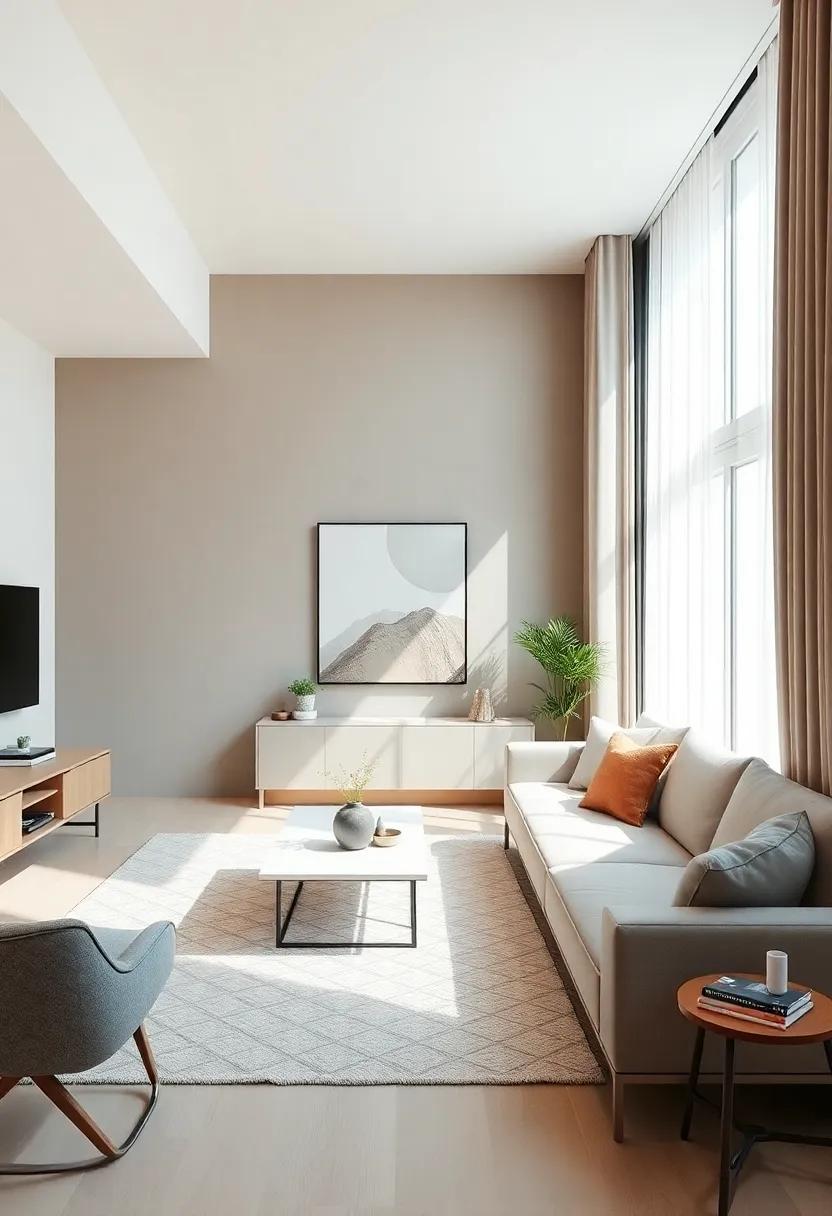
The essence of modern living often lies in the delicate balance between aesthetics and comfort, particularly in transitional designs where minimalism meets inviting warmth. Key elements that navigate this equilibrium include the use of neutral palettes, soft textures, and functional furniture that invites relaxation while maintaining a sleek appearance. To achieve this, consider the following:
- Furniture: Opt for pieces that boast multifunctionality, such as ottomans with storage or sleek, low-profile sofas.
- Textiles: Layering soft throws and pillows in muted tones can add warmth without overwhelming the visual space.
- Rug selection: A large area rug can define a cozy zone, offering contrast against hardwood or tile floors.
Integrating personal touches will further enhance the comfort level without losing the minimalist edge. This can be achieved through curated art displays or subtle greenery that instills life into the space. A harmonious blend of elements might look like the following:
| Element | Example | Effect |
|---|---|---|
| Accent Colors | muted blues and greens | Create a calming atmosphere |
| Lighting | Soft overhead lights with dimmers | Bring warmth and flexibility |
| natural Elements | Wooden coffee tables | Add texture and warmth |
Choosing Eco-Friendly Materials for Sustainable Living
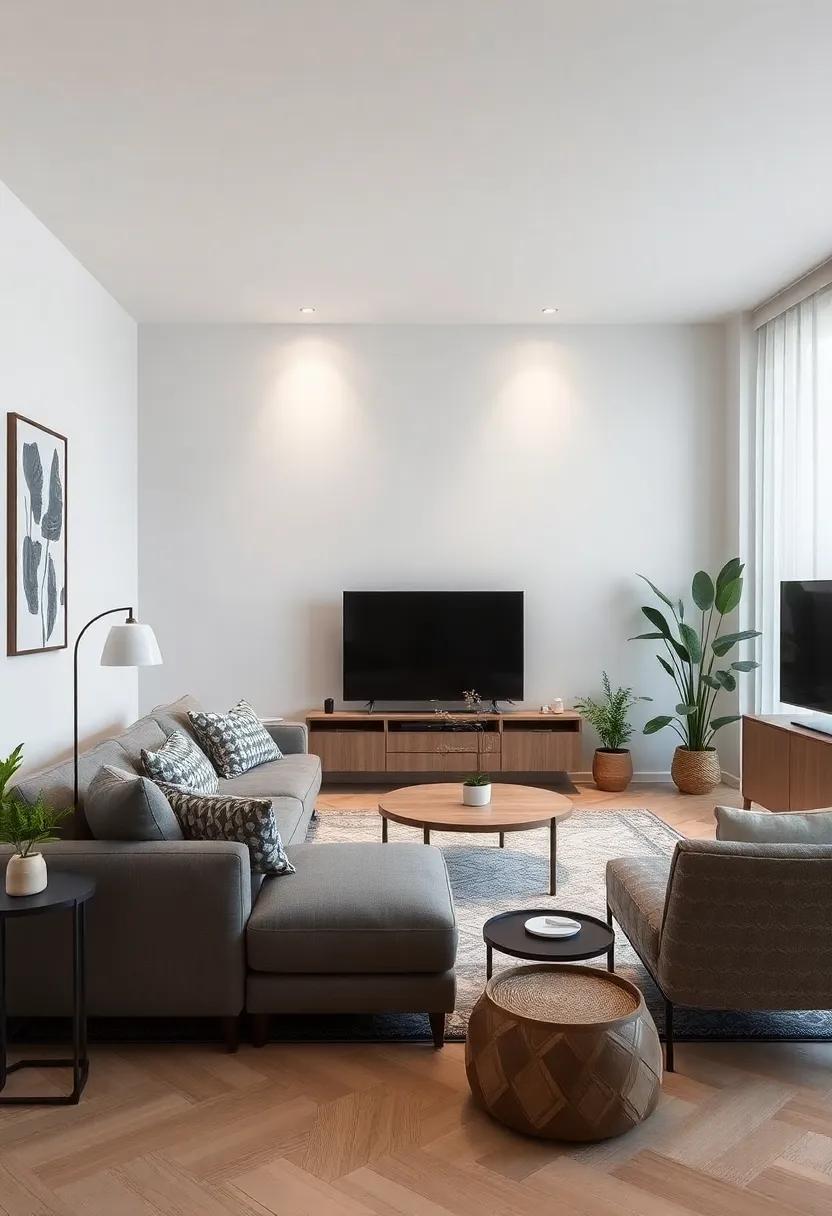
When designing a living room that embodies both modern aesthetics and sustainability, the choice of materials plays a pivotal role.Opting for eco-friendly materials not only contributes to the health of the planet but also creates a unique and inviting atmosphere. Here are some exceptional options to consider:
- Bamboo: Fast-growing and highly renewable, bamboo is perfect for furniture and flooring.
- Reclaimed Wood: Sourcing wood from old buildings or furniture gives your space a rustic charm while reducing waste.
- Recycled Fabrics: Look for upholstery made from recycled plastics or natural fibers, which are both stylish and environmentally conscious.
- Natural Stone: Durable and timeless,natural stone adds elegance without the carbon footprint of synthetic alternatives.
Incorporating these materials not only enhances your living room’s aesthetic but also promotes a lifestyle that respects the environment. Utilizing products with certifications such as Forest Stewardship Council (FSC) can further ensure that your choices support responsible forestry practices. Here’s a quick comparison table that illustrates the benefits of different sustainable materials:
| Material | Benefits | Applications |
|---|---|---|
| Bamboo | Fast growth, biodegradable | Furniture, flooring |
| Reclaimed Wood | Waste reduction, unique character | Furniture, beams |
| recycled Fabrics | reduces landfill waste | Upholstery, curtains |
| Natural Stone | Longevity, low maintenance | Countertops, flooring |
Introducing Greenery for Vitality and Freshness in Interiors
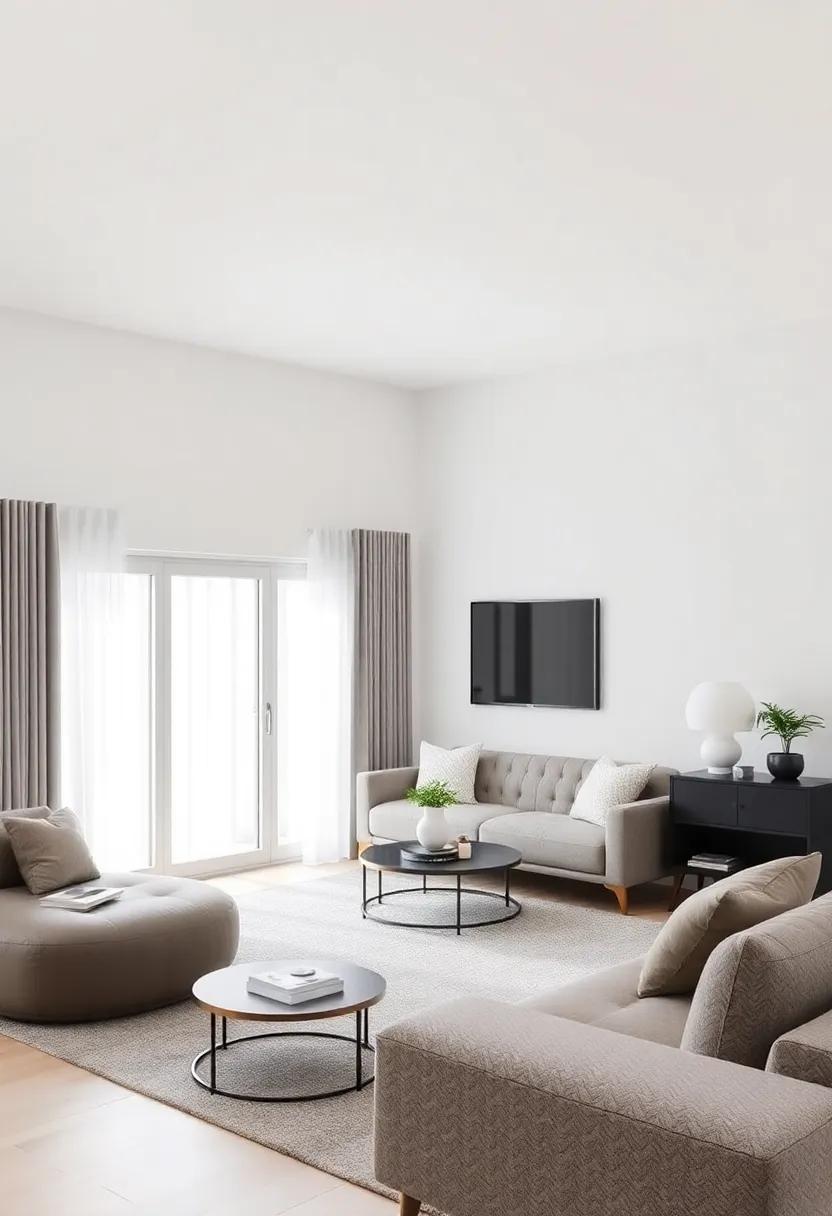
Transforming your living space into a vibrant sanctuary begins with the clever integration of greenery. Choosing the right plants can elevate your apartment’s aesthetics while enhancing your well-being. Consider incorporating air-purifying plants like snake plants and spider plants, which are forgiving and thrive in low light. Succulents and cacti can also add a modern touch with minimal upkeep.Think about using a mix of heights and textures to create a visually appealing arrangement. Hanging planters or vertical gardens can save space while introducing depth and a sense of nature to your interior.
In addition to mere decoration, plants can have a notable impact on your mood and productivity. studies show that having greenery around not only reduces stress but also boosts creativity and focus. Create a balanced atmosphere by clustering plants in groups or mixing them with decorative items such as candles and books. To help you visualize, here’s a simple table showcasing some popular plants ideal for modern living spaces:
| Plant Name | Light Needs | Care Level |
|---|---|---|
| Snake Plant | Low to radiant indirect light | Low |
| Spider Plant | Indirect light | Easy |
| Peace Lily | Low to bright filtered light | Medium |
| Pothos | low to bright indirect light | Easy |
| ZZ Plant | Low light | Low |
Crafting Inviting Atmospheres with Lighting and Accents
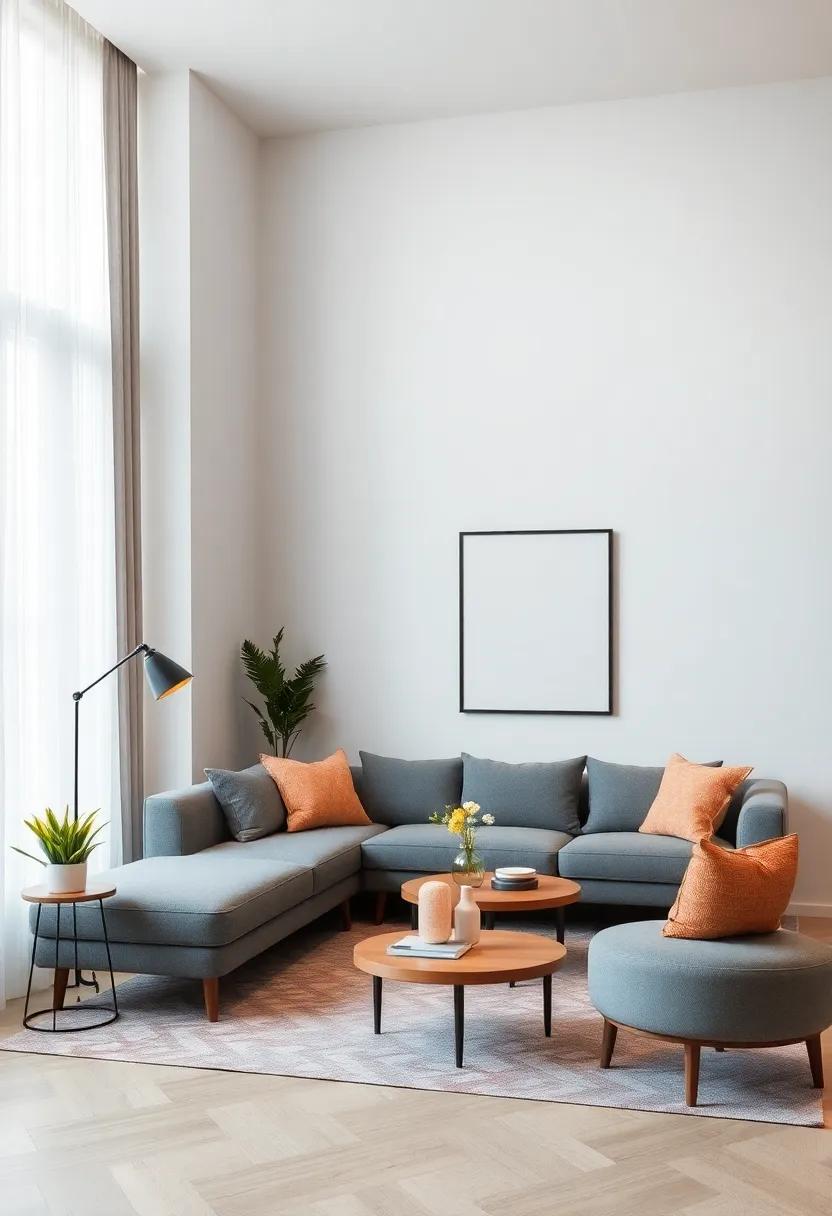
In the journey of designing a living room that reflects the essence of modern apartment life, lighting plays a pivotal role in crafting a warm and inviting atmosphere. From sleek floor lamps to ambient ceiling fixtures,each lighting choice can dramatically alter the mood. Consider layering your lighting strategy to enhance depth and accessibility. Select a combination of task lighting, such as reading lamps beside a cozy couch, and accent lighting that highlights artwork or architectural features. Utilize dimmers to easily transition between vibrant social gatherings and tranquil evenings,allowing flexibility in your space.
Accents are the finishing touches that breathe life into your living space. Incorporate a variety of textures and colors using elements that resonate with your personal style. Here are some thoughtful ways to incorporate accents:
- textiles: Use throw pillows and blankets to add comfort and color.
- Plants: integrate greenery for a fresh and lively feel.
- Art: Choose pieces that tell your story, whether they be paintings, photographs, or sculptures.
- Accessories: Utilize decorative objects like vases or bookshelves to add character.
When harmoniously combined, lighting and accents not only elevate the aesthetic of your living room but also create a narrative that welcomes both residents and guests. Experiment with different styles and placements to find the perfect balance that resonates with the vibrant lifestyle of modern apartment living.
Designing Spaces for Mindful Living and Wellness Practices
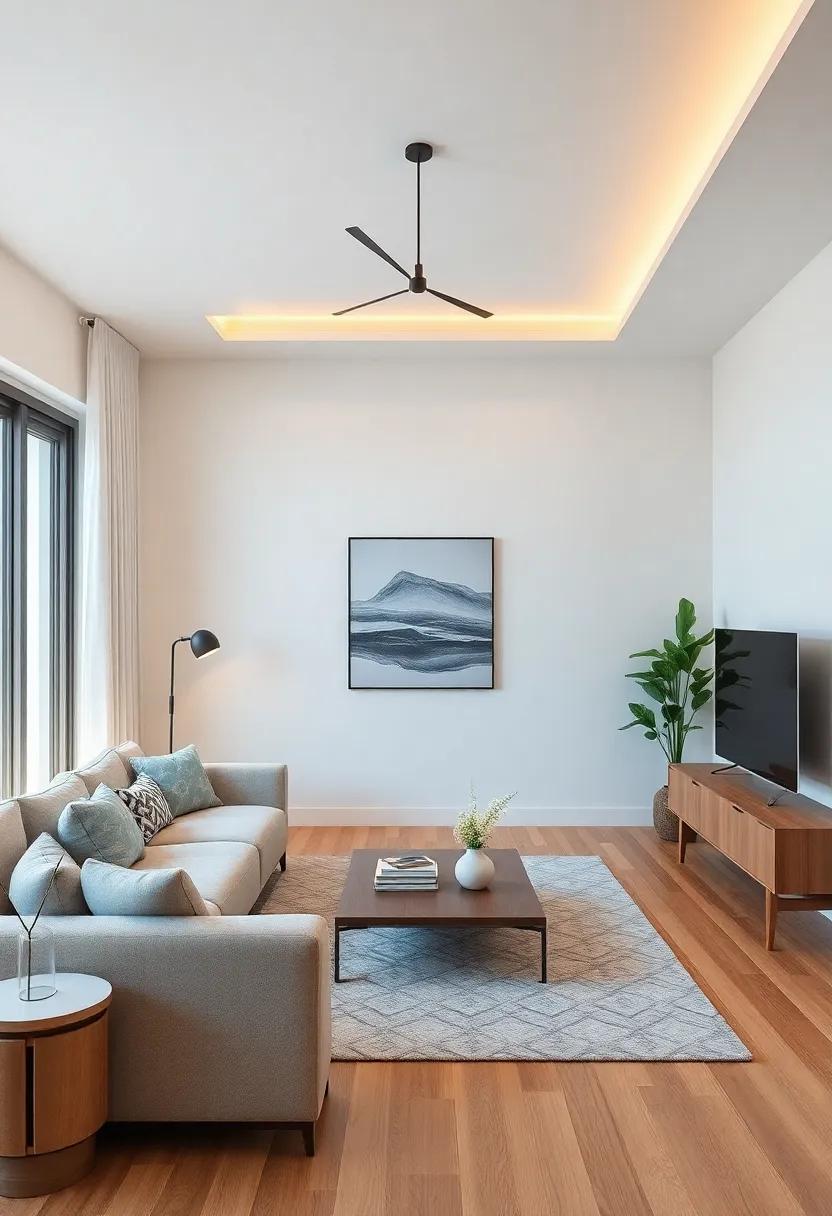
In the quest for holistic wellness, the design of transitional living rooms can seamlessly incorporate elements that promote mindfulness and tranquility. natural light plays a pivotal role in creating an inviting atmosphere, fostering positivity and clarity. Maximizing window space and utilizing sheer curtains can amplify the room’s brightness and create a sense of openness. when choosing colors, opt for earthy tones and soft pastels, which tend to foster a calming effect, reducing stress while enhancing overall well-being. Additionally, integrating biophilic elements, such as indoor plants or natural materials, can bring the serene essence of nature into urban living spaces.
Incorporating multifunctional furniture allows the space to adapt to various wellness practices, whether it be yoga, meditation, or simply unwinding with a book. Consider pieces that can be easily rearranged or concealed, such as ottomans with storage, foldable mats, or nesting tables. A dedicated corner for meditation can be created with a comfortable cushion, surrounded by aromatic candles or soothing artwork. To further enhance the space, the use of a simple table can showcase an essential oils tray or an arrangement of mindfulness tools, such as journals or inspiring quotes, creating an inviting nook for self-reflection and relaxation.
| Element | Benefits |
|---|---|
| Natural Light | Boosts mood and energy levels |
| Earthy Colors | Promotes calmness and relaxation |
| indoor Plants | Improves air quality and reduces stress |
| Multifunctional Furniture | Maximizes space and versatility |
Fusing Traditional and Contemporary Elements for Unique Looks
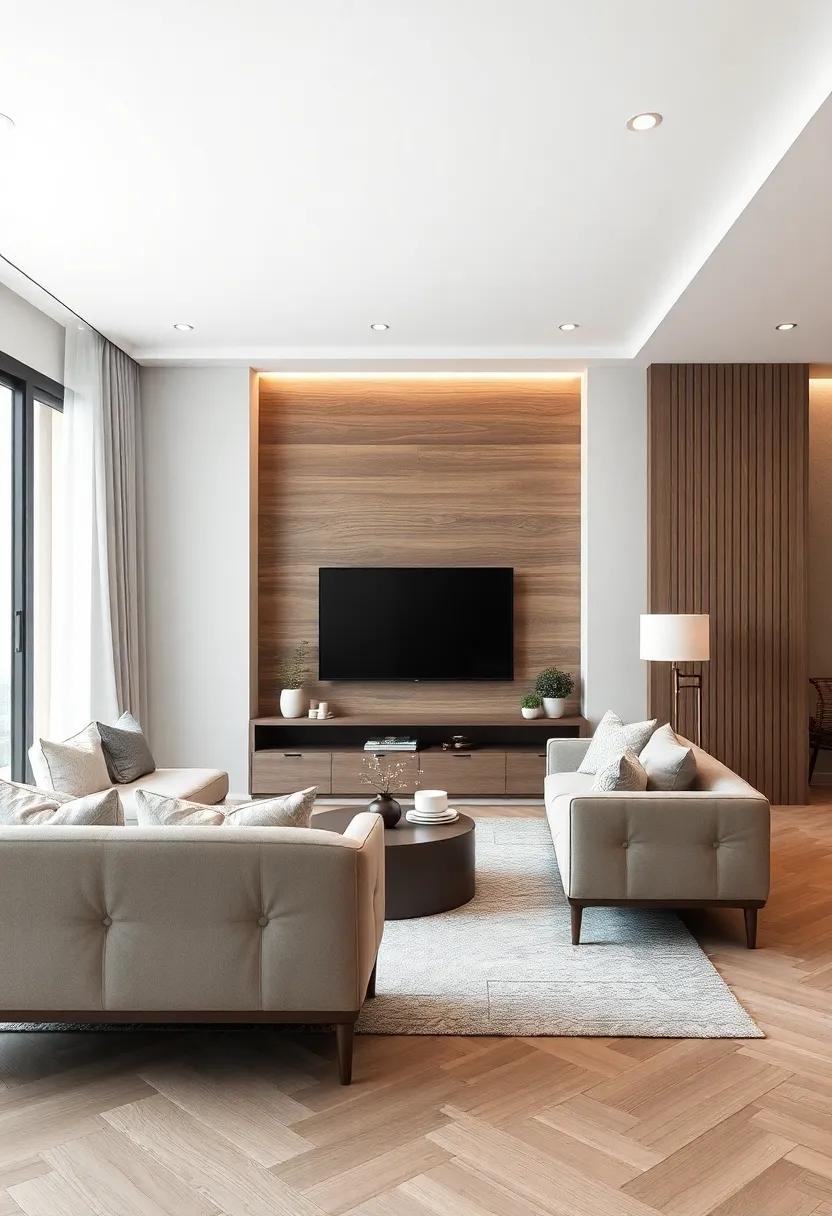
In the quest to create a living room that resonates with both character and modernity, it’s essential to blend traditional design elements with contemporary aesthetics. Consider incorporating classic furniture pieces,such as a vintage armchair or a beautifully carved coffee table,which can serve as stunning focal points. These can be paired with sleek lines and palettes found in modern home décor, allowing each element to complement the other rather than compete. Popular combinations include:
- Neutral color schemes accented by rich textures from traditional fabrics.
- Antique lighting fixtures alongside minimalistic decor items.
- Modern art pieces displayed in ornate traditional frames.
By thoughtfully marrying these design philosophies, you not only create a space that exudes warmth and nostalgia, but also one that feels fresh and inviting. For practical implementation, consider a layout that emphasizes both open spaces and cozy corners. Use a simple table to help illustrate balance in your design choices:
| Traditional Element | Contemporary Element |
|---|---|
| Chesterfield Sofa | Glass Coffee Table |
| Retro Sideboard | Abstract Wall Art |
| Handwoven Rugs | Sleek Mod Chairs |
This fusion not only enhances the visual appeal of your living space but also tells a story of your unique style, celebrating the beauty of both the past and the present.
Curating a Harmonious space for Family and Social Engagement
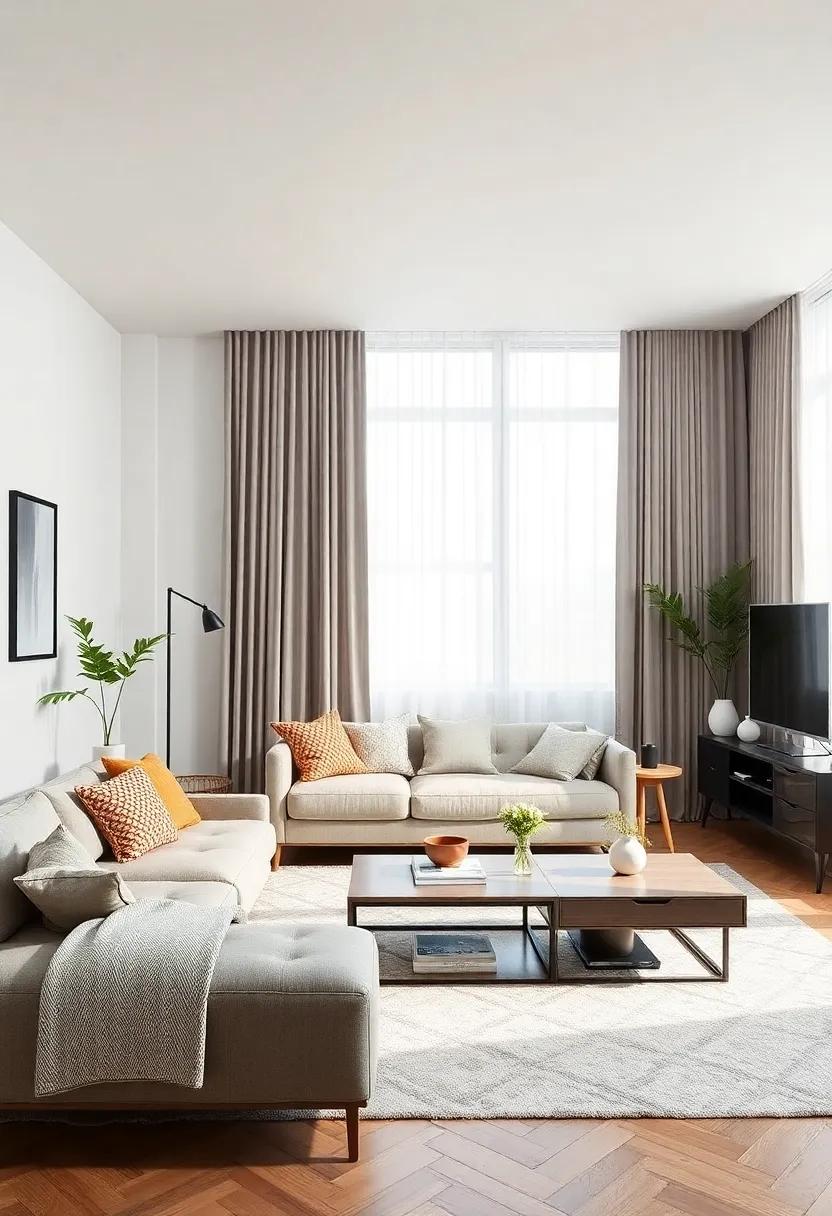
Creating a space that encourages family bonding and social interaction is essential in our increasingly busy lives. Begin by selecting furniture that fosters conversation and relaxation. Consider incorporating:
- Modular Sofas: These versatile pieces can be rearranged based on the occasion,allowing for both intimacy and openness.
- Multi-functional coffee Tables: Opt for designs with storage options or extendable features to accommodate snacks or game nights.
- Soft Lighting: Use adjustable lamps or dimmer switches to set the right mood, making the space feel welcoming at any time of day.
Next, pay attention to the aesthetic elements that promote a sense of harmony. Integrate items that reflect personal stories or family heritage, which can serve as conversation starters. A clever way to organize these elements is through a curated display. Create a focal point using:
| Element | Description |
|---|---|
| Gallery Wall | A mix of framed photos and art that highlights family milestones. |
| Bookshelf | Showcase beloved books alongside personal mementos to spark reflection and discussion. |
| Indoor Plants | Add life and color to the room while improving air quality and mood. |
Imagining Future Trends in Transitional Apartment Living
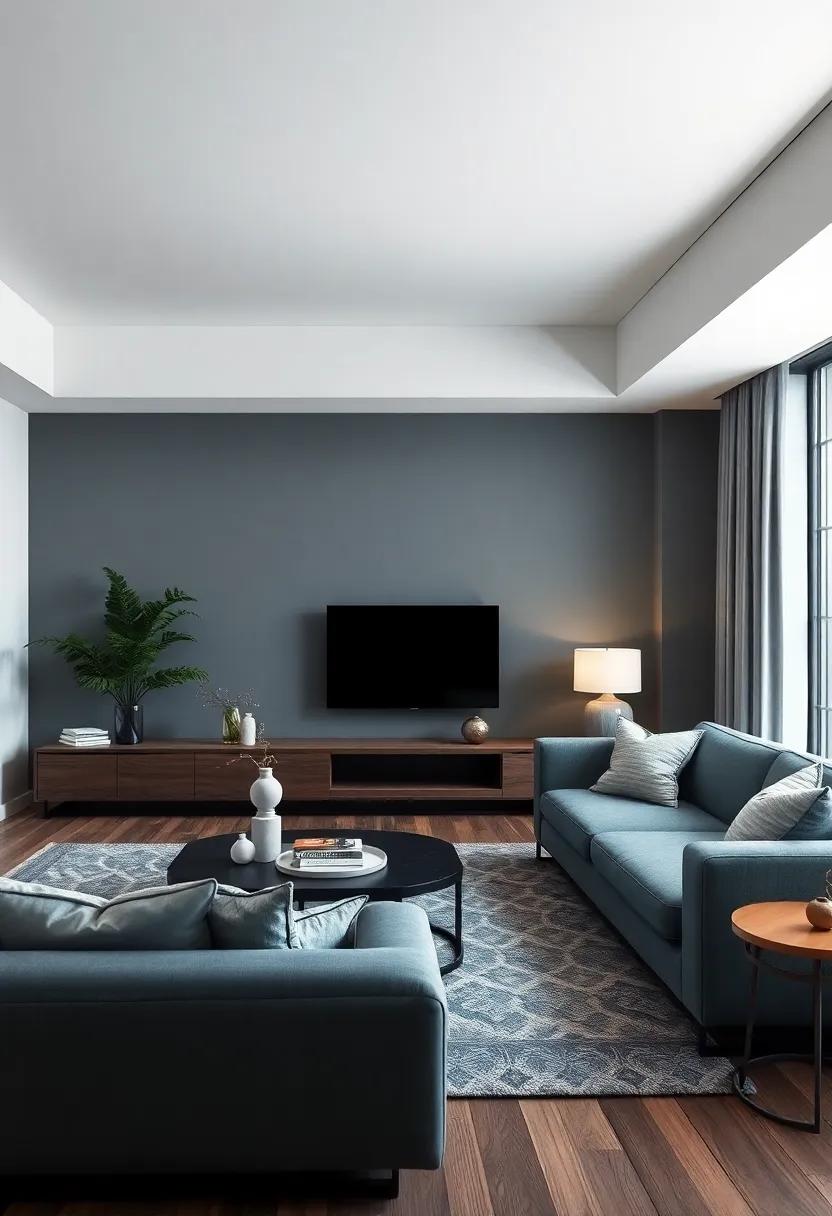
The future of transitional apartment living is poised to embrace a harmonious blend of versatility, sustainability, and technology. as urban spaces evolve, the focus will shift towards multi-functional furniture that enhances the adaptability of living spaces. Imagine sleek sofas that transform into guest beds or coffee tables that double as work-from-home desks. This adaptability not only maximizes square footage but encourages a fluid lifestyle where the living room serves various purposes, from relaxation to productivity. Moreover, the incorporation of smart home technology will become commonplace, allowing residents to control lighting, temperature, and appliances with ease, creating a seamless living experience tailored to individual routines.
In parallel, sustainability will take centre stage, with a rising emphasis on eco-friendly materials and energy-efficient designs. Future trends may include:
- Recycled and upcycled furnishings that add character while minimizing waste.
- Smart energy systems that adapt consumption patterns based on usage.
- Indoor plants and green walls that enhance air quality and visual appeal.
Communal living spaces may also see a resurgence, fostering a sense of community and collaboration among residents. Integrating flexible gathering spaces, complete with shared amenities like co-working areas and rooftop gardens, will promote social interaction while maintaining the privacy of individual apartments. As we reimagine our living environments, the focus will remain on creating spaces that reflect the dynamism of modern urban life while being mindful of our impact on the planet.
Celebrating the Transition Between spaces with Thoughtful Design
In modern apartment living, the concept of a transitional space is essential for promoting harmony and functionality. Thoughtful design plays a pivotal role in creating living rooms that serve multiple purposes, especially as we adapt to new lifestyles and routines. A space that empowers residents to shift effortlessly between relaxation, work, and social activities can be achieved by integrating the following elements:
- Flexible Furniture: Opt for pieces that can be rearranged or transformed to suit various needs.
- Color Schemes: Use calming colors that facilitate a smooth transition between activities and moods.
- layered Lighting: Incorporate different lighting sources to adjust the ambiance based on the time and activity.
Additionally, the aesthetic quality of a transitional living room should reflect individual identity while remaining adaptable. Including natural materials and textures adds depth and warmth, fostering an inviting environment. Considering open layouts allows for a seamless flow between the living room and adjacent spaces, thus enhancing connectivity.The table below summarizes key design features that effectively facilitate transitions:
| Design Feature | benefit |
|---|---|
| Modular Seating | Allows for quick reconfiguration for gatherings or solitude |
| Ambient & Task Lighting | Supports varied activities from relaxation to focused work |
| Dividers | Creates visual distinction without isolating spaces |
Future Outlook
As we navigate the ebb and flow of contemporary living, our spaces must evolve alongside us. Designing a transitional living room isn’t just about aesthetics; it’s about adaptability, comfort, and creating a sanctuary where every change is welcomed with open arms. By harmonizing style and function, we can craft environments that reflect our multifaceted lives, accommodating everything from quiet evenings of reflection to lively gatherings with friends.
In embracing change, we don’t merely respond to our surroundings—we actively shape them, fostering a sense of peace and creativity. So, whether you’re reimagining your existing space or starting fresh, remember that each choice you make is a step toward a home that grows with you. After all, the true beauty of a transitional living room lies not just in its design, but in its ability to adapt, inspire, and transform, embodying the very essence of modern apartment life. Let your living room tell the story of your journey, embracing change as a part of the beautiful tapestry of everyday living.
